“A Jeep® Life”
by
Moses Ludel
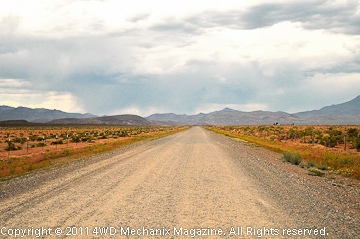
Nevada’s Washoe County Road 34 near the Black Rock Desert playa leads from Gerlach to the Sheldon Antelope Range. By late May, the snow-capped Granite Mountains become Jeep four-wheel drive country!
Piercing white headlamp beams shot through the Ponderosa boughs, starkly silhouetting the quaking aspen grove. Droning steadily, the feisty ‘Hurricane’ F-head engine broke a pre-dawn silence. I grabbed the gearshift lever and angled the Jeep steeply upward.
At that altitude, the final stretch pressed the CJ-5 to its gradient limits. The four-cylinder power persisted willingly, backed by dramatic gear reduction. Above us, Genoa Peak stood prominently along the Sierra crest, shrouded by an ink black, star-filled sky. I parked the CJ, and we quietly pulled out the rifles and gear. Ahead, punctuated by steep terrain, spiny Manzanita brush and acclimated mule deer, was the day’s hunt…
The 1964 CJ-5 was our family’s first four-wheel drive, a replacement for the ’56 Volkswagen. Mom worked at Carson-Tahoe Hospital, and the four season climate threatened her swing and graveyard shift commutes. Fronting the Sierra at 4,800 feet elevation, Carson Valley knew sub-zero temperatures, chilling wind and blinding blizzards.
Dad fueled our autos regularly at Minden’s C.O.D. Garage. “Brick” Hellwinkel’s sons, Dan and Don, handled the business. Don managed vehicle sales, and Dan ran the shop. An office display rack, standing crooked on the aged plank floor, held Chevrolet, Buick and Jeep brochures. That brisk fall morning, the oil stove and pipe took the edge off.
“Leonard, there’s a new Jeep CJ-5 in the Pioneer Garage building…You’ll want to look at it,” Don said, setting down his notepad and pencil. Reaching for the brass doorknob, he pointed toward the storage barn. “This one has the optional four-speed transmission and a 1/3-2/3 front seat.”
Fall leaves skittered across Esmeralda Avenue as we stepped through the crooked wooden doorway into the dimly lit structure. Immediately visible was a ‘Nordic Blue’ Wagoneer. Dad followed Don Hellwinkel to a topless CJ-5. The CJ, still coated in Cosmoline, shone in the streaking sunlight.
The barebones CJ would easily pass for Korean War materiel—were it not for the upbeat, Spruce Tip Green metallic color. “Mom’ll like this one!” I thought.
Fresh off the transport, sans a roll bar, heater-defroster, seat belts or free-wheeling front hubs, the CJ model had just a driver’s side windshield wiper and side view mirror. Don Hellwinkel and the Jeep brochures explained that the Jeep Universal was a 1/4-ton 4×4 truck, typically used for brute field work. Dealer-installed accessories were available.
I carefully opened the Jeep’s externally latched hood while my father and Don discussed a heater and defroster system, the right side wiper kit, a right side mirror, a drawbar trailer hitch, Cutlass free-wheeling front hubs and a Whitco light green cloth top with matching spare tire cover. These dealer-installed options, discounted to enhance the sale, upped the CJ-5’s $2,300 base price to just over $2,600.
A month after the Jeep acquisition, I tested for my learner’s permit. On my sixteenth birthday in the spring, I gave the DMV license examiner at Carson City a memorable ride in that CJ-5. By that time, our winter commuting vehicle had also accessed Nevada ghost towns, remote gravel byways and rugged two-track trails. I had driven Highway 95 to Tonopah where we stayed at the Mizpah Hotel. Forking off U.S. 6 toward Belmont and Manhattan, I wheeled the folks through high desert valleys to Austin, discovering the Jeep’s nuances as we explored the isolated backcountry.
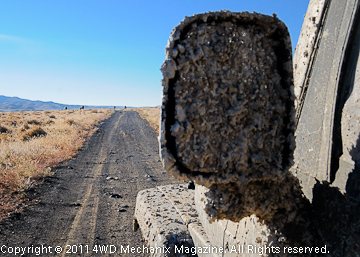
Feral horses on today’s Nevada range, a small herd with stallion and harem harks back to the ‘sixties Pine Nut Range. Despite encroachment by people and vehicular traffic, herds have grown. When the author’s family moved to Carson Valley in 1963, Nevada’s population was less than 350,000 people—fewer than 1,200 lived at Carson Valley. Today, 30,000 live at Carson Valley and 2.6-million inhabit Nevada, yet wild country, horses and Jeep 4WDs prevail.
Closer to home, the CJ combed the Pine Nut Range alongside wild horses, traversed Sunrise Pass into nearby Smith Valley and explored Ludwig, Pine Grove and Rocklin, ghost towns from Nevada’s mining past. Driver’s license in pocket and the snow drifts melted, I would extend the Jeep’s tracks to Bodie, Aurora and Lucky Boy Pass. Two years later, in the summer of 1967, I would traverse the notorious Rubicon Trail, plying the difficult back route from Lake Tahoe to Ice House.

This view along the notorious Rubicon Trail could well be the author and friends in the summer of 1967. AMC-era CJs remain popular. When modified properly, they tackle rugged backcountry with ease. Moses Ludel has tested many 4WDs on this trail and prefers shorter wheelbase Jeep 4WDs.

Near the west end of the notorious Rubicon Trail, a 93.4-inch wheelbase CJ-7 pauses. In tow is a venerable WWII military “flat-fender” with three snapped axle shafts. The tortuous, boulder strewn Rubicon Trail demands reliable trail modifications.
Hunting, a Carson Valley rite of passage, assigned additional duties to the CJ-5. With its twin-stick transfer case and low range four-wheel drive, the Jeep scaled old mining roads to reach deer country. Mulies, Ringneck pheasants, mallards, Snow Geese, Canadian Honkers, Chukar, mountain quail and cottontail rabbits—the Jeep parked patiently near alpine meadows and hayfields, hedgerows and autumn ditches, mud-banked waterways and frozen ponds.
Fishing improved as the Jeep accessed remote bends in the Carson and Walker Rivers. Undiscovered, shady banks and eddies offered up German Browns and rainbows. Tiny creeks, lined with grey sagebrush, hid high desert brookies.
Jeep 4WD Country
By the early ‘sixties, Carson Valley was four-wheel drive territory. Ranchers had discovered the mettle of 4×4 surplus trucks and gravitated to Willys’ Jeep CJ Universal, 4WD Pickup and 4WD Station Wagon. WWII and Korean War vets, familiar with military MB, MC and M38A1 models, were now sportsmen raising families.
Ford, G.M., Dodge, I-H and Studebaker had entered the growing 4WD light truck market. Jeep met that challenge with boldly innovative new models. Kaiser purchased Willys-Overland in 1953, renaming it “Willys Motors.” Gladiator J-truck and Wagoneer introductions coincided with Kaiser’s strategic formation of Jeep® Corporation in 1963. The Wagoneer and Grand Wagoneer became the longest running platform in automotive history—twenty-eight model years. Kaiser, American Motors and Chrysler profited from this Brooks Stevens design.
Jeep® Corporation sold vehicles through a string of Nevada dealerships. By the mid-‘sixties, Reno’s Cal-Vada Motors boasted the largest per capita Jeep sales in the United States. (Seemingly impressive, Nevada’s population at the time was less than 400,000 people.) The seventh largest state at 110,567 square miles, Nevada’s mean elevation of 5,500 feet was prime Jeep 4WD country!
At Carson Valley, J-trucks attracted ranchers and utility users while the spartan CJ-5 and CJ-6 Universal served agriculture, mining and a growing number of recreational outlets. Built on a substantial J-truck 4WD platform, the smooth riding Wagoneer became the world’s first true sport utility vehicle (SUV). In wood trim, the 1966 ‘Super Wagoneer’ could be seen at local civic meetings, gun clubs and the country club.
A crossover vehicle, the Wagoneer also ferried gun dogs and goose decoys, brought home groceries in the throes of winter and provided a tough four-wheel drive alternative that delivered car-like ride quality. AMC’s 327 ‘Vigilante V-8’ engine option in late 1965 encouraged add-ons like power steering, power brakes, power windows, a tilt steering column and the rugged G.M. Turbo-Hydramatic transmission. Jeep now offered the world’s first luxury station wagon with all-wheel drive!
Early spinoffs of the Wagoneer included a short-lived 2WD option and an ill-fated attempt at a 4WD independent front suspension system. A two-door wagon and a utility panel truck also made the model list. In the winter of 1965-66, Jim Stratton, the pharmacist at Minden, offered me a holiday season job delivering prescriptions with his 1965 J-panel truck. Under the hood was an AMC 232 cubic inch inline six, the first year for that engine offering.
An overstressed powerplant for such a hefty 4WD vehicle, the seven-main bearing 232 did outperform its predecessor, the ill-fated Jeep ‘Tornado’ 230 cubic inch inline six. America’s first overhead-camshaft truck engine, the 230 rested on an outdated, four-main bearing block assembly. Plaguing 1962-64 Wagoneer and J-truck models, the OHC Tornado continued to challenge the U.S. military’s M715 trucks through 1969.
The pharmacy’s panel wagon had a column shift three-speed transmission and manual steering. Fortunately, the prescriptions did not weigh much, and to its credit, the truck did get respectable traction on the icy streets of Gardnerville and Minden. Having mastered soda jerking to the point of boredom, I was pleased when the holiday season ended and a service station job opened.
Returning to the familiar surroundings of trucks, muscle cars, a tire changer and lube room rack with tune-up equipment, I happily pumped high-octane gas and advanced my mechanical skills. Admittedly, I missed the prattle of the local ranchers who frequented the pharmacy’s fountain counter on their mail run to the Minden Post Office. A brief reprieve from spreading hay in blinding snowstorms and rescuing heifers entangled in barbed wire, the ruddy men huddled over cups of hot coffee, discussing the raw weather, deep Sierra snow drifts and the projected price of alfalfa.
The Jeep has always left room for personalizing, and the ‘sixties muscle car rage, coupled to Nevada’s basic speed law, spilled over to CJ and vintage Willys models. At Carson Valley, one CJ-6 boasted a Ford Mustang V-8 transplant and a Warn overdrive. Gardnerville’s Postmaster, Hank Rosenbrock, shoehorned an aluminum 215 Buick V-8 into his Kaiser-era Jeep CJ. Innovative and impressive, Hank’s swap attracted Jeep® Corporation engineers. They pored over the Jeep’s engine bay, taking photos and copious measurements.
Two years later, the Jeep CJ-5 and CJ-6 option list included a Buick iron 225 V-6. Jeep engineers opted for General Motors’ rugged alternative, dubbing it the “Dauntless V-6.” Eclipsing the F-head 134 four by 88 horsepower, the odd-firing, 160 horsepower V-6 engine served CJs and the Jeepster through 1971. The G.M. aluminum 215 V-8, a coin toss from Jeep’s option list, found its way into the 1970-up British Land Rover and Range Rover.
A Modern Contender
4×4 light utility vehicles, patterned off the “flat-fender” WWII MB model, were a Jeep mainstay from the postwar period through the early ‘sixties. The CJ-5 Universal, introduced in 1955, mimicked the M38A1 (Korean War era) military 4×4. An F-head (in-block exhaust valves, in-head intake valves) 134 cubic inch four-cylinder engine, derived from the WWII 134 L-head engine, raised the hood line of the 1953 Willys CJ-3B model. F-heads powered the CJ-5 and CJ-6 until the AMC/Jeep era. Underpowered for modern highway use, demanding very low (numerically high) axle ratios like 5.38:1, the L- and F-head four-cylinder engines were no match for America’s freeways and rising speed limits.
In late 1960, the International Harvester Scout 80 came to market. Ranchers preferred single-point vehicle and parts sourcing, and Meneley Motors, the I-H dealership, sold rugged ‘All-Wheel Drive’ I-H pickups, a variety of cab-chassis models and the Scout.
A striking match for the 101-inch wheelbase Jeep CJ-6, the 100-inch wheelbase Scout 80 called for a small displacement, four-cylinder engine. I-H split its overhead valve 304 V-8 in half, creating an innovative “slant 4” of 152 cubic inch displacement. Featuring five rugged main bearings, this modern engine dwarfed Jeep’s three main bearing, 72-horsepower 134 four-banger with roots to 1930s Willys cars.
When encouraged to spend time at highway speeds, the 6.9:1 compression, long-stroke ‘Hurricane 134’ inline four had a knack for burning holes in piston crowns. Aggravating this issue, higher elevation markets like Carson Valley got the “high altitude” F-134 package with 7.4:1 compression. When driven at sea level, especially at speed, the added compression was a sure way to retire a piston or two! The folks’ 1964 CJ-5 suffered this fate at less than forty-thousand miles—trips included one Interstate 80 run to the Bay Area and two Death Valley outings.
Jeep and I-H outsourced many of their parts from the same suppliers. Sharing similar axle, transmission and transfer case designs, the Scout 80 models were heavier, placing more load on these components. Plagued by rear axle failures in the 1961-66 models, the Scout could not leverage its modern 152 engine advantages. A 1965-67 turbocharged 152 option produced 111 horsepower and snapped even more axle shafts. When Jeep introduced the 225 Dauntless V-6 in 1966, the CJs leaped past the four-cylinder Scout offerings.
An unexpected challenger was the rugged, 90-inch wheelbase Toyota FJ40 Land Cruiser. Imported into the United States from 1960-83, powered by a rugged inline six, the FJ40 4WD developed a formidable reputation and loyal following. Esteemed as a direct competitor and trail rival to the CJ Jeep models, the FJ40 remains a four-wheeling icon.
Outsourcing AMC and Buick engines kept Jeep competitive with the emerging ‘Big Three’ 4WD trucks and SUVs. With Jeep® Corporation using the Buick V-6 in the CJ models, Buick’s 350 V-8 became a logical option for J-trucks and Wagoneers. By the time Kaiser sold Jeep® Corporation to AMC in 1970, “Dauntless 350 V-8” engines were a proven marketing tool for Jeep sales. Standard J-truck inline sixes were reliable AMC designs.
By 1972, when AMC introduced its first Jeep models, Jeep® Corporation competed in a burgeoning recreational four-wheel drive market. Hunters, anglers, all-weather commuters, outdoor-oriented families and utility companies clambered for Chevrolet’s Blazer, GMC’s Jimmy, an upscale G.M. Suburban and the refined Scout II. By 1974, Dodge and Plymouth entered the market with the Ramcharger and Trailduster.
Enthusiast to Jeep Professional
Between 1968 and 1970, I worked as a light and medium duty truck fleet mechanic at National City, California. Restoring and wheeling a 1950 CJ-3A flat-fender Jeep in my off-hours, I combed the washes and hills of San Diego County, trekked around the Anza-Borrego Desert and climbed Coyote Canyon. Recollections of sparsely populated Nevada and the rugged Sierra Rubicon Trail colored my view of urban Southern California.
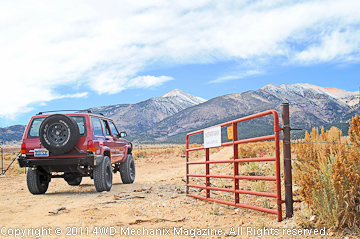
The Sweetwater Range runs north from Bridgeport, California to the Pine Nut Range. Mt. Patterson looms ahead at 11,371 feet and once teemed with prospectors and miners. This country is accessible by Jeep CJs, Wranglers and 101.4-inch wheelbase XJ Cherokees (shown).

Southeast of Mt. Patterson, quaking aspen and juniper color the range. Browse, water and brush provide excellent mule deer habitat. Less snowfall than the nearby Sierra Range makes this area accessible from June through October or early November.
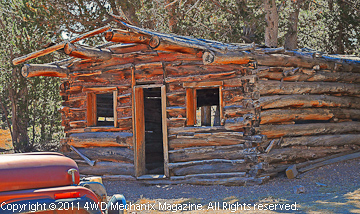
Even higher than nearby Bodie or Aurora, Patterson Mining District emerged in the 1880s. A shorter wheelbase Jeep 4WD can reach Belfort’s 10,210 foot elevation where some buildings remain. Check for road conditions, as the low-range road can suffer from weather.
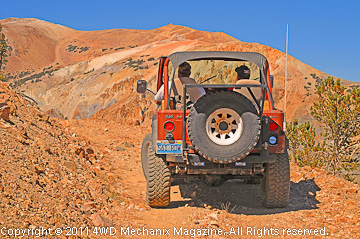
A Jeep CJ-7 climbs a narrow mining road straddling the California-Nevada line. The Sweetwater Range, typical of Nevada’s high desert Jeep country, was mineral rich and created decades of mining booms and busts in the late 19th and early 20th Centuries.

Fall and browse, high desert reaches provide a rich diet for mule deer. Quail abound at lower elevations while mountain lions, coyote and black bear frequent the region. Further east across Nevada, habitat is similar. Imagine growing up here and having access to a Jeep CJ-5!
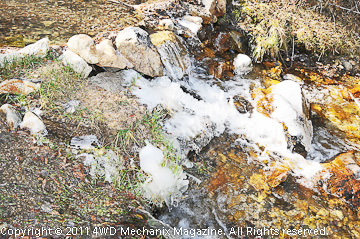
Cold nights, light snows, fall unfolds between October and mid-November. Winter settles into the region and grips high elevations until late May or June. Nevada’s 125 mountain ranges and mean elevation of 5,500 feet has made Jeep 4WDs popular since the first WWII MB came out of a surplus sale.

The Nugent Cabin in the Sweetwater Range is a unique opportunity to glimpse an earlier time. An honor system makes the cabin available on a first-come basis, and users respect the provisions. The U.S. Forest Service keeps this stocked line cabin open when weather allows, and a 4WD Jeep can readily reach the cabin in season. Guests add provisions and most leave the cabin as found or better.
Returning to Nevada meant access to Elko County’s Ruby Mountains, the Santa Rosas and the Sweetwaters. Bird, deer and waterfowl hunting, spring and fall angling, each called for four-wheeling. Through the mid-‘seventies, I worked hard and played hard. Heavy-equipment operating jobs like the Interstate 80 bypass of Winnemucca meant off-hour mule deer hunting atop Hinkey Summit in the Santa Rosas.
Though access to extraordinary country, working remote highway jobs conflicted with rearing kids. Wife Donna and I headed our family toward Eugene, established Oregon residency, and I entered the University of Oregon in the fall of 1977. Motivated and mustering a semblance of maturity by age twenty-eight, I would complete my bachelor’s program in nine quarters.
While at the U of O on a paltry budget, we hunted the Cascade and Wallowa Mountains, fished wild rivers like the McKenzie and Willamette, and balanced an outdoor life and four-wheeling with academe. I taught son Jon to hunt mule deer on Bartlett Bench above the Grande Ronde River. Fishing for steelhead in Lake Creek and the Siuslaw River, we splintered an inadequate trout rod. When not stacked with textbooks and Okie drifters, the tiny dining table at married student housing served up Donna’s venison stew and grilled Northwest steelhead, often to a line of impoverished colleagues.
I graduated Dean’s List as AMC enjoyed its ninth successful model year with Jeep products. Jeep has always been a success story. When Willys-Overland floundered with its postwar Willys Aero car line, the Jeep’s WWII legacy spurred sales of CJs, 4WD Utility Pickups and 4WD Station Wagons. Kaiser, with its own car line troubles, purchased Willys-Overland in 1953. Though Kaiser’s cars failed soon thereafter, Kaiser transformed its Willys Motors into the successful Jeep® Corporation, prompting an American Motors purchase in 1970.
Similarly, AMC’s gradual decline in the automobile market would be offset by AMC/Jeep sales of the 4WD CJ, full-size Cherokee, Grand Wagoneer and J-truck models. In a visionary move, AMC introduced the XJ Cherokee model in 1984, a unitized body 4WD that drew on features from the CJ and Eagle 4WD cars. In step with rising fuel costs and downsized automobiles, the “compact” XJ Cherokee led the SUV market away from gas guzzling, V-8 powered SUVs.
The XJ Cherokee fostered the sale of AMC/Jeep® Corporation to Chrysler in 1987. Chrysler’s primary interest was Jeep. The XJ Cherokee ultimately sold 2.8-million units between 1984 and 2001, achieving the greatest platform success in Jeep history.
By late 1982, Jeep became part of my own success story. As a budding four-wheel drive journalist, strategically located at Southern California, I fed articles to four-wheel drive publications. Despite economic recession, industry malaise, draconian emission controls and a flood of Japanese vehicles, Jeep drew upon its traditional strengths: four-wheel drive, truck stamina and access to a free-spirited, remote backcountry lifestyle!
Given the gearing advantage of a low range transfer case, restricted horsepower did not inhibit the Jeep. Despite fuel saving axle gearing and catalytic converters, the classic CJ continued to meet its off-pavement goals! 2.5L fours and AMC’s ultra-reliable, seven-main bearing 4.2L inline six survived the stifling constraints of the carbureted emission control era.
The full-size Cherokee fell victim to CAFE standards and left the model lineup after 1983. Jeep’s luxurious Grand Wagoneer would persevere with a carbureted AMC 360 V-8 through 1991, retired by the unitized body 1992 Grand Cherokee.
As AMC/Jeep handed the reins to Chrysler in 1987, the Wrangler had just replaced the time-honored CJ model. An updated platform, the YJ Wrangler featured a lower center of gravity than the CJs. This move evolved from a 1980 media attack that ended CJ-5 production. In a CBS 60-Minutes expose, the deleterious effects of a higher center of gravity and shorter wheelbase were highlighted.
Indisputably, a shorter wheelbase coupled with high ground clearance and a narrow track width does create a greater propensity for rollover. The Jeep CJ’s purpose for that short wheelbase, narrower track width and higher ground clearance dates to the legendary Jeep MB performance in WWII—churning through North African sand, Burma mud, across swampy Pacific Islands and through Battle of the Bulge snow!
Jeep engineers offered a 4×4 that traditional users expected. As backcountry four-wheelers, many of us lamented the loss of the CJ-5. The longer wheelbase CJ-7, YJ Wrangler, TJ Wrangler, and today’s even longer and wider JK Wrangler, have begged modification. To perform off-pavement like the vintage CJ-5, a JK Wrangler four-door with 116-inch wheelbase requires a chassis lift and 37-inch diameter tires!

Though a newer TJ Wrangler, this profile could easily be the author’s 1964 CJ-5. Some Jeep attributes remain timeless, especially the freedom and access they represent. If the “journey is the destination,” what a way to get there!
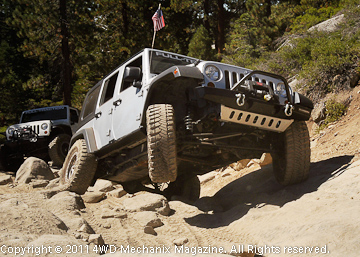
A truck-like chassis with a wide track width, the JK holds center-of-gravity in check. For negotiating the rugged Rubicon Trail, this JK Wrangler Rubicon Unlimited features a six-inch chassis lift and 37-inch diameter tires to offset the 116-inch wheelbase.
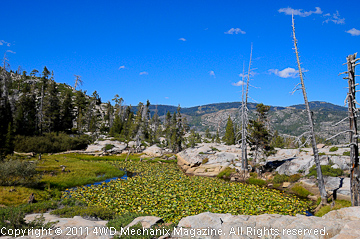
The scenic Rubicon Trail and Desolation Valley have served Native Americans, miners, hunters, anglers, horseback riders and hikers. A notable Jeep four-wheel drive challenge, the trail requires special equipment, which includes chassis lift kits and oversized tires. The Pacific Crest Trail runs through the adjacent Desolation Wilderness Area.
Objectively, a longer wheelbase, wider track width vehicle has less rollover tendency and offers improved evasive maneuvering. Driving a vintage, short-wheelbase Jeep Universal requires respect for its higher center of gravity and sensitive steering response. For decades, I have discussed these trade-offs and offered technical solutions.
Spreading the Jeep Word
Ranking high among my Jeep memories, I competed at the AMC-sponsored Jeep Cup Rally final near Reno, Nevada in 1987, wheeling a YJ Wrangler. The following year, I covered the Chrysler/Jeep Cup Rally final north of Toronto, Ontario—for five magazines on three continents. ’88 Wranglers forged cold Canadian streams and proved their Jeep prowess.
In 1989, prompted for a book proposal by Robert Bentley Publishers, I drew upon twenty-five years of Jeep exposure. A book contract and freelance writing outlets provided our much desired ticket out of urban Southern California. We returned to Oregon in 1990, and the Jeep® Owner’s Bible™ emerged. When not writing, my 1981 CJ-5, an OFF-ROAD Magazine project, accessed Roosevelt elk and volunteered for Lane County Search and Rescue duty.
Conducting annual workshops at Chrysler’s Camp Jeep® has provided a hearty exchange with owners. We share the many ways Jeep 4WDs enhance our lives. Some ask about the 1987 Grand Wagoneer that I restored for Donna. Others want details on the modifications I made to the trail-use Wrangler. Four decades after my CJ-3A adventures, our son-in-law Kevin, daughter Angela and granddaughter Ciara four-wheel that Wrangler at Anza-Borrego Desert.
Today, the Jeep model lineup offers a unique yet timeless profile. High-end luxury and ride quality, like the latest Grand Cherokee, hark back to the boldly innovative ‘sixties Super Wagoneer. Four-wheel drive tractability infuses the Compass, Patriot, Liberty and Grand Cherokee, each targeting competitors ranging from entry level AWDs to world class SUVs. The JK Wrangler and Unlimited, meeting a Jeep commitment that now spans seven decades and seven corporate logos, continues a tradition of backcountry prowess, rugged trail access and four-wheel drive, light truck stamina.
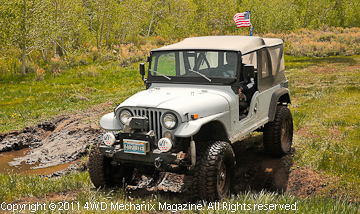
This lightly modified Kaiser-era Jeep CJ-6 is ‘Dauntless V-6’ powered. The CJ-6 added 20-inches of wheelbase to the 81-inch CJ-5. Available from 1966-71, the Dauntless V-6 CJs enabled Jeep to compete with Ford’s Bronco, the I-H Scout and Toyota’s FJ40 Land Cruiser.
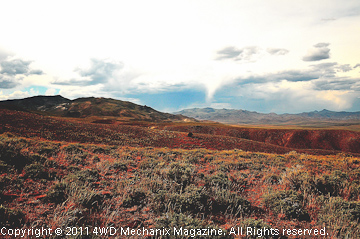
A Granite Mountain storm in springtime, high desert “Jeep country” offers vast, colorful panoramas and wildflowers. Nutrient rich snow melt nurtures deer and antelope. Aspen and alpine meadows line the higher reaches, much like the Pine Nut Range.
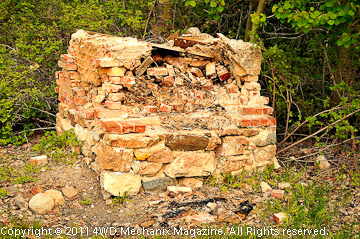
“Basque Oven” at the eastern slope of Granite Peak recalls when sheep herding was a northern Nevada mainstay. Towns like Gardnerville, Winnemucca and Elko have thriving Basque communities with renowned, “family style” restaurants and festivals.
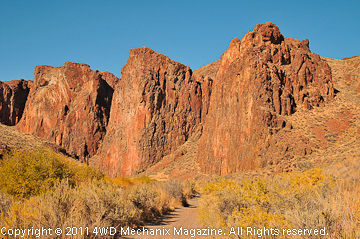
High Rock Canyon road leaves Soldier Meadows, passes through Fly Canyon and enters High Rock Canyon Conservation Area. A B.L.M. protected historical site, this exciting, colorful Jeep trip traces the Applegate-Lassen and southern Oregon Trails.

Driving through High Rock Canyon, the author’s multi-purpose XJ Cherokee readily negotiates a steep, loose section without wheel spin. The Jeep features a six-inch lift, 33-inch diameter tires, ARB Air Locker differentials, a Warn winch and heavy-duty bumpers.
In a rapidly changing world, one constant is our penchant for outdoor living. Access to backcountry and a sporting life defines us. A stalwart companion on this innervating journey has been Jeep!
Lingering Jeep Tales
Every Jeep enthusiast has a story. Mine grew into a saga that now spans forty-seven years. Like all stories, this one has a beginning, just months before I learned to drive.
My father, a newcomer at the time to four-wheel drive, had a keen sense of adventure. He found his match in our Jeep ‘Universal’ CJ-5, bought new in the fall of 1964. Purchased as an all-season commuting vehicle, the Jeep promptly revealed its 4WD prowess.
The family cabin, overlooking Twin Lakes near Bridgeport, California, required annual winterizing and boarding up. On a Saturday in November ’65, we headed down Highway 395 under dark, gathering clouds. As the road left Carson Valley and entered the Pine Nut Range, a light snow called for intermittent use of the windshield wipers.
Closing the cabin went uneventfully. The Old Town canoe fit readily into its berth, while water drained steadily from the shutoff valves. Busy with chores, we were oblivious to the five inches of snow that had accumulated by early afternoon. Hubs locked and the transfer case in ‘4WD High’ mode, the Jeep pulled sure-footedly up the steep gravel drive approaching the Twin Lakes Road.
In the thirteen miles to Bridgeport, the sticking powder deepened. At 6,500 feet elevation, snow blew horizontally across the valley floor, ushered by gale winds that crested the jagged, surrounding peaks. As we turned north on Highway 395, the town looked deserted in the rear view mirrors. Fortunately, we had fueled at Bridgeport en route to Twin Lakes.
Gardnerville, just 69 miles away, was a familiar drive. Staying in 4WD mode, we set the heater controls for maximum heat at the higher fan speed. With a cloth top, this was just enough warmth to keep the windshield defrosted and ice from forming on the zippered plastic windows. Bare steel floorboards gave new purpose to my Redwing boots and wool socks.
As we climbed out of the Bridgeport Valley, the four-cylinder engine pulled unflinchingly through each gear change. Devil’s Gate Pass, at 7,519 feet elevation, wreaked the brunt of a Sierra blizzard. The Jeep clawed through eight inches of trackless snow and crested the summit. No snow plow in sight, the sun set dimly behind the westward peaks.
Highway 108, seasonally closed beyond Pickle Meadows and the USMC Mountain Warfare Training Center, jutted west at Sonora Junction. Within a mile, Highway 395 plunged headlong into the twisting Walker Canyon. The asphalt now lay buried under ten inches of snow, and road markers defined our route.
Stark white CJ headlamp beams scanned the steep canyon walls and captured a mule buck and two does, scampering into a stand of Ponderosa pine. Midway through the canyon, ice buildup stalled the wiper blades. Stopping in the midst of a white, desolate roadway, we stepped from the Jeep and skidded across the partially buried step plates.
The rushing West Walker River roared at our backs, drowning out the steadfast engine noise. Our fingers numb from peeling ice off the wipers, coats draped with snow, we clambered into the cab. Hunched over the spartan defroster vents, we slid our boots beneath the dashboard, seeking the warmth of floorboard heater ducts.
Once again, the Jeep clawed forward, now pushing snow near the front bumper’s height. After a seemingly endless spell, the canyon opened into Antelope Valley. The tiny settlements of Walker and Coleville, pocked with porch lights and wisps of stovepipe smoke, offered welcome signs of life and hearth.
Snowfall waned at Topaz Lake and the Nevada border. Bridgeport to Topaz, a fair-weather drive of less than an hour, had taken us more than four hours. Beneath the flood lights at the closed California Agricultural Inspection Station, we stopped long enough to pour a second spare can of gasoline into the CJ’s near empty, 10-gallon fuel tank. After fumbling with the ice-covered can, its stiff flex nozzle and a freezing filler cap, my fingers were wet and swollen red as I climbed back into the Jeep.
Though the highway had more than a foot of fresh snow on each shoulder, Nevada’s plows had kept the road clear to Carson Valley. The few inches of slush posed no challenge, and at nine o’clock that evening, we cut fresh tracks up our Gardnerville driveway.
Headlines in the next morning’s Reno Gazette described a Highway 395 snowstorm spanning from Mammoth Lake Junction to Topaz Lake—closing lengthy sections of that highway! Unwittingly, we had blazed a fifty-mile path through a severe Eastern Sierra blizzard.
My lifetime commitment to Jeep 4WDs began on that snow packed stretch of Highway 395. Since then, my family has owned seven Jeep 4x4s. Each has contributed a dramatic chapter to our story. For all of the adventures, whether crawling the rocky Rubicon Trail, accessing primitive hunting haunts or recreating over long weekends, I owe a debt of gratitude to one stalwart, feisty four-cylinder workhorse—the 1964 Jeep CJ-5 that took us home that night.
Note: Moses Ludel has authored seven technical books, including the bestselling Jeep® Owner’s Bible™ (now in its Third Edition, Bentley Publishers, Cambridge, MA) and two Jeep® CJ Rebuilder’s Manuals. 4WD Mechanix Magazine is a digital website devoted to Jeep 4×4 enthusiasts, overland travelers and 4WD technical buffs. A past board member and 4WD instructor for Tread Lightly, Moses consults to manufacturers and trains individuals and groups at 4WD technology and backcountry driving. Video production is available as well. To discuss your video project or corporate consulting needs, contact us at videos@4WDmechanix.com. This email address is for commercial and business use only, thanks!
